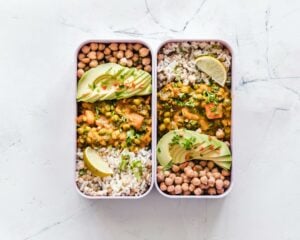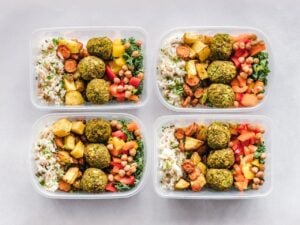Food Storage & Defrosting Tips 101

Once you receive your Gobble box, it’s easy to practice safe storage and handling of our ingredients in order to maintain freshness and avoid any risk of food-borne illness. Simply follow these tips!
Meat and seafood
Meat and seafood should be refrigerated immediately, and either cooked or put in the freezer to store within 5 days. Though we take great care in packaging our food, it’s always a good idea to use extra freezer-safe wrapping when freezing ingredients. This helps prevent freezer burn and keeps your ingredients tasting great.
Fruits, veggies, herbs
There is a huge variety of fruits, vegetables, and herbs, and they can’t all be treated the same. Some require greater care to maintain freshness and taste. Bonus: It also has great tips for preventing food waste!
Bread
Breads can be stored at room temperature for up to 5 days, or in the fridge for up to 2 weeks. Bread also freezes well. Be sure to wrap it well in freezer paper. You can thaw it in the fridge when you’re ready to use it, or you can take individual frozen pieces and pop them in the toaster or in an oven at a “warming” or low heat setting.
Prepared sauces, soups, fresh pastas, etc.
Prepared ingredients, such as sauces, soups, and raviolis, should be refrigerated immediately. They will maintain their best quality and taste for up to 5 days. Not ready to use them? They can also be frozen for 2 to 3 months.
Safely defrost frozen ingredients (or cook from frozen).
When you’re ready to use your frozen items, there are 3 safe defrosting methods recommended by the USDA:
- Use your refrigerator. This method requires a little planning ahead because it can take a full day to thaw some ingredients. But this is a very safe method that limits the threat of bacteria growth. Once thawed, food can remain safely in the refrigerator for 1 to 2 days. If you’ve changed your mind, food thawed with this method is safe to refreeze without cooking.
- Use cold water. While this is quicker than defrosting in the fridge, cold water thawing isn’t a “set it and forget it” method. Put your frozen ingredient in a leak-proof bag or container and submerge in cold water. Change the water every 30 minutes. When defrosting this way, there’s no turning back: You have to be committed to cooking the food once it’s thawed, and you cannot refreeze.
- Use your microwave. The amount of time you’ll need to set on your microwave will depend on your ingredient and your microwave. We recommend starting on low settings in small time increments, and periodically checking in. Food that’s in the process of defrosting in the microwave is not safe for handling, so always wash your hands after you’ve given it a test poke. Like with the cold water method, food defrosted in the microwave must be cooked right away. Once fully cooked, you can refreeze it if you’d like.
You can also skip defrosting and directly cook frozen food. It will take about 50% longer to cook than it would if it wasn’t frozen, so be sure to account for that when planning.



